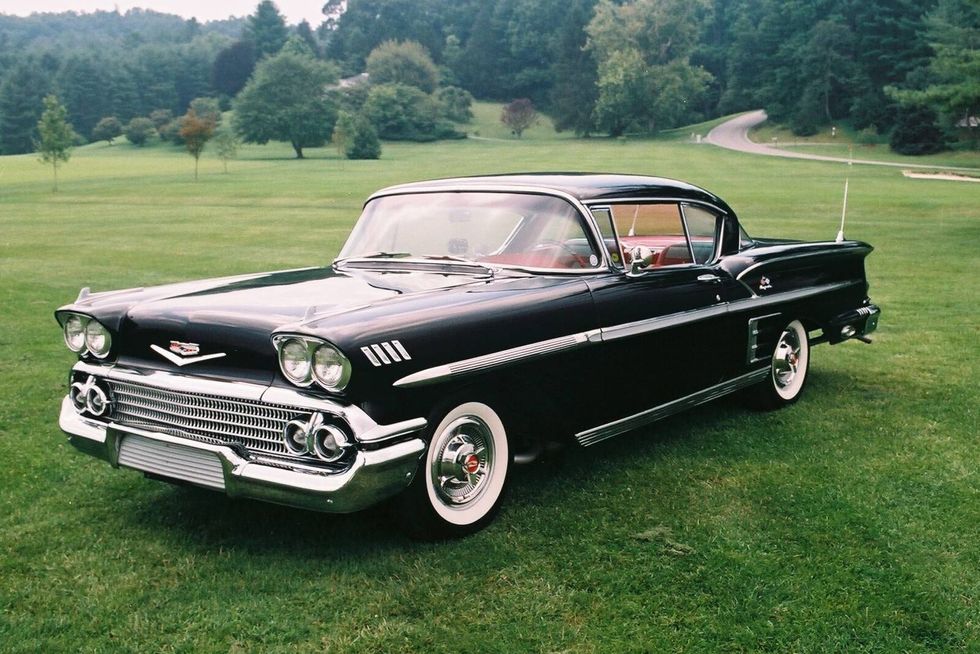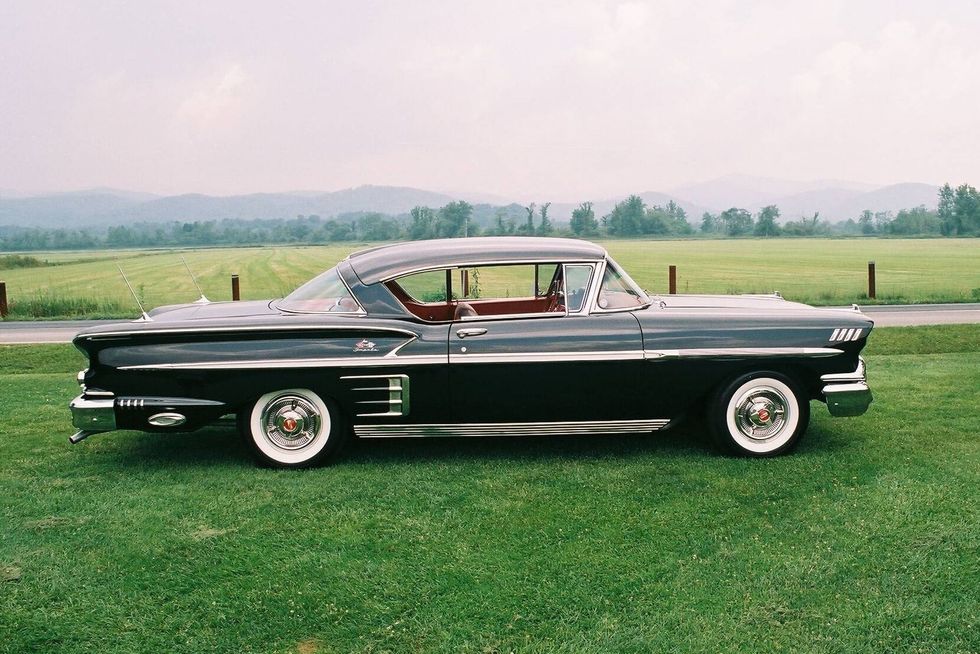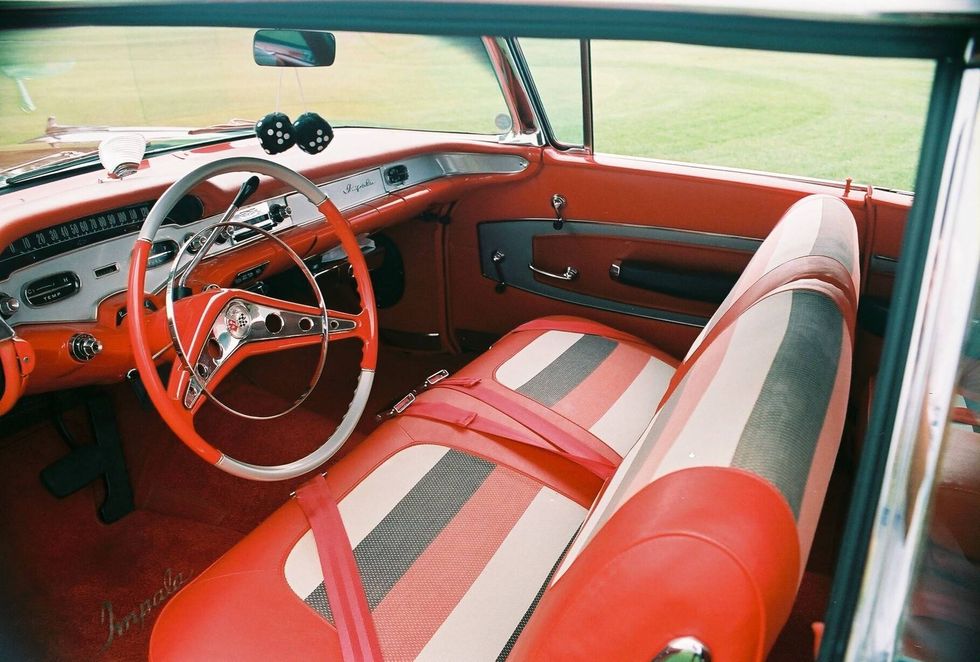
Buy
Resources
Entertainment
Magazine
Community
In This Article
Category:
Magazine
When GM repealed its 400-cubic-inch limit on its mid-sized models for 1970, it finally leveled the playing field with Chrysler and Ford, and Oldsmobile was prepared for battle. Its 455-cu.in. engine, which was introduced in 1968 and featured in the Hurst Olds, Toronado and full-size models, became the standard 4-4-2 powerplant, rated at 365 hp. Opting for the W-30 "W-Machine Package," however, would provide significant additional benefits.
Available first in 1966 on the 400-cu.in. Tri-Carb 4-4-2 and continuing with a four-barrel thereafter, the W-30 was a comprehensive go-fast option package. For 1970, with 55 more cubes on tap, the Force-Air-inducted W-30 455 was rated at 370 hp at 5,200 RPM and 500-lb.ft. of torque at 3,600 RPM.
The two-bolt main block has a 4.125-inch bore and the nodular-iron crank a 4.250-inch stroke. Forged-steel 6.735-inch connecting rods are pinned to aluminum alloy pistons. "Select-fit" engine parts in Olds-speak meant that those for the W-30 were chosen from specific groups to attain the most advantageous weight match and clearances.
For four-speed cars, the aggressive #402569 cam features 328/328-degrees advertised duration and .475/.475-inch lift. The #400165 cam was for the automatic-equipped W-30 and has 285/287-degrees duration with .472/.472 lift. Inside the refined F-casting (H-1971 and Ga-1972) cylinder heads are 2.072/1.625-inch valves, and heavy-duty valve springs and 1.60:1 shaft-mounted rocker arms were used. The compression ratio is 10.5:1.
Oldsmobile replicated the stock cast-iron intake manifold in aluminum to reduce weight for the W-30, and the Quadra-jet carb and Delco breaker-point ignition system were dialed-in to the package. Cast-iron exhaust manifolds flow into 2.25-inch head pipes, twin mufflers and 2.00-inch tailpipes, and the exhaust system ends in chrome trumpet tips that peek through cutouts in the rear bumper. A six-blade clutch fan was also added.
The W-30 included additional components to further exploit its capabilities and add style. The Force-Air-inducted dual-scooped and wide-striped W25 fiberglass hood with chromed tie-downs lops off pounds and directs cold outside air to the hungry carb via an air-cleaner assembly that's sealed to it. Reduced sound deadener saves more weight, and body side stripes and W-30 emblems draw attention, and so do red plastic inner fenderwells, as shown here on Ed Pienta's 1971 W-30 4-4-2.
Mandatory options include an M21 close-ratio four-speed with Hurst shifter or a performance-calibrated M40 Turbo Hydra-Matic 400 with a special torque converter; the G92 Performance Axle Package with 3.42:1 gears (or G88 with 3.91:1 gears), Anti-Spin and heavy-duty radiator (steeper rear gears could be dealer installed); PK5 G70-14 raised white letter bias-ply glass-belted tires and body-colored sports-styled mirrors with remote controlled driver side.
An optional W27 aluminum rear axle carrier and cover saved about 22 pounds. The W26 Hurst-Dual Gate shifter in the sport console was also available at extra cost.
Unlike the W-30 400s that came before it, for 1970, A/C was available, but only with the M40 trans, power brakes and 3.23:1 gears.
Since the W-30 was an option for the 4-4-2, the famed FE2 suspension and 14 x 7-inch wheels were already included. Manual front disc brakes were standard on the W-30. Power assist was available only for automatic-trans W-30s.
The W-Machine Package was offered in the 4-4-2 Holiday coupe, sports coupe (post) or convertible, and total cost was $369.68, including W-30 at $321.23, D35 mirrors at $22.12 and PK5 tires at $26.33.
What was it worth on the drag strip? Car Life ran the quarter-mile in 14.36 at 100.22 MPH in a 1970 4-4-2 W-30 with an automatic and 3.42:1 gears, two people aboard, test equipment and a 4,195-pound test weight. Hot Rod ran 14.10 at 100.55 MPH in street trim with its W-30 test car featuring the automatic and 3.91:1 gears.
For 1971, there were mechanical changes. Most notably, the compression ratio dropped to 8.5:1 to meet looming federal emissions regulations to ensure engines could run on low-lead, no-lead or regular fuel.
According to Oldsmobile's Engine Assembly Manual, the W-30 four-speed cam was tamed to #409759 with 294/296-degrees advertised duration and .472/.472-inch lift. For the automatic, it became #409691 with 286/287-degrees duration and .474/.472-inch lift and #400165 was employed for the W-30 with the automatic and A/C and measured 285/287-degrees advertised duration with 472/.472 lift.
Net power ratings were being adopted industry-wide and provided a more accurate measure of engine output by dyno testing them while outfitted with the accessories--air cleaner and alternator etc.--that would be on them when installed in the actual car. As a result, the W-30 455 was rated at 350-hp gross and 300-hp net and torque was 460-lb.ft. gross and 410-lb.ft. net.
The W-30 Performance Package included much of the same equipment and mandatory options as in 1970, and the four-speed or the automatic transmission was once again mandatory. For 1971, however, a wide-ratio M20 four-speed was added and the close-ratio M21 four-speed was replaced with the famed close-ratio M22. The 3.90:1 rear gear choice was reduced to 3.73:1 but the other previous year's gear choices remained.
Dropped from the line was the 4-4-2 sports coupe (post). Cost for the W-30 Performance Package in 1971 was $369.67 without power brakes, $347.56 with them. The W27 option was reduced to an aluminum differential cover, foregoing the aluminum carrier of the previous year.
For 1972, the W-30 (L77) retained its 300 hp at 4,700 RPM and 410-lb.ft. of torque at 3,200 RPM ratings, but was not available in California. The M22 close-ratio four-speed was dropped, leaving the wide-ratio M20 and the M40 Turbo Hydra-Matic as the only choices.
The 4-4-2 reverted back to option status. Thus the W-30 Performance Package included the items of previous years, as well as the new W29 4-4-2 Appearance and Handling Package, which added the FE2 Rallye Suspension, wheel opening moldings, 4-4-2 grilles and emblems, and any striping that didn't conflict with the W-30.
Since the 4-4-2 was no longer its own model, the W-30 was available on the Cutlass Holiday coupe, Cutlass S sport coupe and Holiday coupe and the Cutlass Supreme convertible (and the Hurst Olds). Including the previous year's items, plus the W29 4-4-2 option and G80 Anti-Spin rear, the W30 Performance Package cost $719.34 with power brakes and $741.45 without, on the Cutlass. On other models, it was cheaper.
Though the cam specs for the four-speed and automatic W-30s were carried over, A/C was not available with the W-30 in 1972, which negated the need for the A/C cam and the 3.23:1 rear gear that had come with it the previous year. The red plastic inner fenderwells were also discontinued.
Super Stock Magazine tested a W-30 4-4-2 with an automatic trans and 3.42:1 rear end and ran a best of 14.47 near 100 MPH.
As can be expected for a purpose-built machine, production numbers for the W-30 4-4-2s are quite low. For 1970, 3,100 W-30s were built. Additionally, Oldsmobile assembled two W-30 Vista Cruiser wagons. Sales receded to 920 W-30s for 1971 and just 772 for 1972.
The reputation that the W-30s cultivated for potent yet sophisticated performance has reached much further than the model's low production volume would suggest and they remain highly coveted and collectible muscle cars. Though W-30s were offered before 1970 and the name was employed again sporadically after 1972, 1970 represents the zenith for power and the depth of the available package components and options, and the 1971 and 1972 versions weren't that far behind. They stand as remarkable reminders of a bygone era when the 455-based W-30 excelled in acceleration without compromising all else...too much.
Special thanks to Fred Mandrick.
Recent
For 1958, all-new styling at every General Motors passenger-car division ushered in big changes, just as the corporation was celebrating its 50th anniversary. It was also the final year with Harley Earl at the helm of GM design. Though the new models were longer and lower in proportion than in previous years, Earl’s signature use of excessive chrome remained unabated. That brightwork continued a trend that had dominated automotive design throughout the Fifties. For 1958, it worked seamlessly with those new designs that presented a broad departure from previous years.
Currently listed on Hemmings Auctions are a pair of faithfully restored hardtop coupes from the GM catalog from that momentous year. With wide chrome grilles surrounding four headlamps and copious brightwork including side trim the length of the body, this 1958 Chevrolet Impala Sport Coupe and 1958 Pontiac Bonneville Sport Coupe both handsomely display the heavily Earl-influenced styling that made headlines for GM.

1958 Pontiac Bonneville Sport Coupe
While GM made general announcements and events around its 50th anniversary for 1958, only Pontiac incorporated the occasion into its advertising. It mattered little that the first Pontiac rolled off the assembly line in 1926 as sub-brand of Oakland. Laid out in large letters in its brochure, Pontiac’s advertising theme for 1958 carried the tagline “The boldest advance in fifty years,” also declaring “A new kind of cars is born!” Previously introduced as a well-optioned convertible version of the Star Chief in 1957, the standalone Bonneville arrived for 1958.
Promising “the first true union of sport car action with town car luxury,” the Bonneville was only produced as a pillarless hardtop Sport Coupe or a drop-top Sport Convertible for 1958. As “a modern ultimate for the man who loves cars…this steel-muscled road machine,” the Bonneville featured a 370-cu.in. V8 engine with a four-barrel carburetor and 10:1 compression as standard equipment. An optional Tri-Power setup with triple two-barrel carburetors was given the “Tempest 395” moniker for its 395 lb-ft torque rating.

As the late 1950s was peak Jet Age, aeronautical and rocket themes pervade the details of the Bonneville. The leading edge of the scalloped rear quarter panels featured a very rocket-like piece of chrome trim that extended to a point at the front of the car. On top of each front fender, just before the headlamps, sat additional chrome-plated pieces that resembled delta-wing jets with appendages that lead into creases atop the fenders like contrails from jet engines.
Finished in Burma Green with Calypso Green accents, this 1958 Bonneville Sport Coupe, one of 9,144 produced, appears to have been restored some years ago, with a fit and finish that looks to be holding up. It is equipped with the Tri-Power 370 and a four-speed Super Hydra-Matic transmission. It is additionally fitted with power windows and power brakes, along with the rare Trans-Portable radio unit that can be removed and used as a portable radio with its built-in speaker and ability to run off batteries. The seller notes no problems with the drivetrain and asserts that the transmission shifts well.

1958 Chevrolet Impala Sport Coupe

Chevrolet didn’t revel in the golden jubilee news that Pontiac touted, but its advertising in 1958 suggested that its redesigned models were “Almost too new to be true!” The ad copy also promised that “You’ll like being looked at in your beautiful ’58 Chevrolet.” Longer, lower and wider than the famous “Tri-Five” models that preceded it, the Chevrolet models somewhat mirrored what was going on at Pontiac, but with a rear-end treatment that seemed to show the previous year’s tall tailfins flopped over somewhat. In magazines ads, the words accompanying the first-year Impala Sport Coupe suggested “This sleek styles-setter promises action, gaiety, glamor—and it keeps its promises beautifully.”
Like the Bonneville nameplate, the first Chevrolet to wear the Impala badge arrived in 1958. Chevy also introduced its first big-block V8, the so-called “W” engine. For 1958, Chevrolet dubbed this 348-cu.in. engine the Turbo-Thrust V8 when equipped with a four-barrel carburetor and Super Turbo-Thrust when fitted with Tri-Power triple carburetion. Though it lacked the aviation/space themes of the Bonneville’s styling, the similarly proportioned Impala was also festooned with plenty of brightwork, from the wide grille to side spears that ran nearly from the taillights to the headlamps. Pound-for-pound, the massive wraparound bumpers probably contained the highest amount of chrome on the car.

Finished in Onyx Black with a bold Rio Red-dominated interior, this 1958 Chevrolet Impala Sport Coupe now on Hemmings Auctions features a long-term restoration that spanned the 1990s. Completed in 2001, it appears to be holding up well. The photos of the very clean undercarriage that accompany the listing tell a story that the car has been taken care since that redo. This example is fitted with the four-barrel 348 that was rated at 250 horsepower when new. Power reaches the rear axle via a two-speed Powerglide automatic transmission.
GM made some distinct design changes for 1958. With plenty of models across five passenger-car divisions, we are fortunate to have options in the collector car hobby when it comes to these chrome-laden machines. Which of these ’58 hardtop coupes would you like to cruise in?
Head on over to Hemmings Auctions to take a look and let us know.
Keep reading...Show Less
YouTube / Auto Archaeology
You know when Ryan Brutt from the YouTube channel Auto Archaeology posts a new barn find video, it’s bound to be good. He’s been traveling around the country for over a decade documenting unique barn and garage finds, especially Mopars and other classic muscle cars. This 1969 Dodge Charger R/T is no exception, though he admittedly found it first on Facebook Marketplace, not his usual way of locating cool barn find cars.
The Dodge Charger in question was reportedly stored away for 30 years until recently. “Not my usual way to cool cars,” Brutt writes, adding, “This garage find has been sitting in this garage we think for 30 years. At least the neighbor who had lived there for 30 years didn't even know the car was in there.”
Under the decades of dust, it still sports the factory F5 Medium Green Poly paint and was originally equipped with a vinyl roof. Granted, the body has seen better days, and the muscle car is clearly in “barn find condition.”
1969 was the second year for the Charger R/T model. It came standard with the 440 cubic-inch (7.2-liter) Magnum, or an optional 426 cubic-inch (7.0-liter) Hemi. This example houses the 7.2-liter V8 under the hood, factory rated for 375 horsepower and 480 lb-ft of torque. It’s paired with an automatic gearbox.
1969 Charger R/T Rescued from Garage after 30 years!youtu.be
In a second video, Brutt shares the satisfaction of watching the dirt-caked Challenger receive its first wash with its new owner. Here’s what it looks like to have 30 years of grime washed away:
1969 Charger R/T Garage Find First Wash in 30 Years!youtu.be
In 1969, Chrysler built 69,142 Chargers. Of that number, 20,100 were R/Ts, according to the Standard Catalog of Chrysler 1914-2000. When the 1969 Dodge Charger R/T was first released, its original MSRP was $3,592. According to classic.com, the average used price of a 1969 Dodge Charger R/T like the one found here is $106,278, with the highest sale currently maxing out at $275,000. As of this writing, there are nearly a dozen 1969 Dodge Charger models for sale on Hemmings Marketplace.
Keep reading...Show Less





